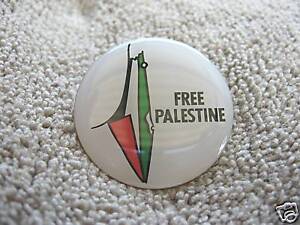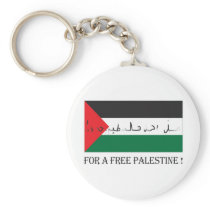Source(google.com.pk)
Free Palestine Badge Biography
Free Palestine Fight Zionism' badge, alternatively known as a button, brings attention to the long-standing animosity between Palestine and Israel. The state of Israel was declared on 14 May 1948. A separate Jewish state had been proposed by the League of Nations following World War I, and again following the Holocaust in World War II. In 1947 plans to divide Palestine were again proposed by the United Nations. Despite Israel's creation in 1948, many Palestinians and neighbouring countries did not support its being. There has been conflict in the middle-east ever since.
Zionism refers to the movement for the return of Jewish people to their homeland and for that homeland to be located in Israel.
Description:
This is a circular badge with the Palestinian Flag used as the background (colours: red, green, white, black). It has white printed text encircling the upper and lower halves. Pin on the back.The Palmach (Hebrew: פלמ"ח, acronym for Plugot Maḥatz (Hebrew: פלוגות מחץ), lit. "strike forces") was the elite fighting force of the Haganah, the underground army of the Yishuv (Jewish community) during the period of the British Mandate of Palestine. The Palmach was established on 15 May 1941. By the outbreak of the Israeli War for Independence in 1948 it consisted of over 2,000 men and women in three fighting brigades and auxiliary aerial, naval and intelligence units. With the creation of Israel's army, the three Palmach Brigades were disbanded. This and political reasons led to many of the senior Palmach officers resigning in 1950.[1]
The Palmach contributed significantly to Israeli culture and ethos, well beyond its military contribution. Its members formed the backbone of the Israel Defense Forces high command for many years, and were prominent in Israeli politics, literature and culture.
The Palmach was established by the Haganah High Command on 14 May 1941. Its aim was to defend the Palestinian Jewish community against two potential threats. Firstly the occupation of Palestine by the Axis in the event of their victory over the British in North Africa. Secondly, if British army were to retreat from Palestine, Jewish settlements might come under attack from the Arab population. Yitzhak Sadeh was named as Palmach commander.[2] Initially the group consisted of around one hundred men. In the early summer of 1941 the British military authorities agreed to joint operations against Vichy French forces in Lebanon and Syria. The first action was a sabotage mission against oil installations at Tripoli, Lebanon. Twenty-three Palmach members and a British liaison officer set out by sea but were never heard of again.[3] On 8 June mixed squads of Palmach and Australians began operating in Lebanon and Syria. The success of these operations led the British GHQ to fund a sabotage training camp for three hundred men at Mishmar Ha'emek. Since the Palmach consisted of unpaid volunteers, the funding was used to cover the needs of twice that number of men.[4] When the British ordered the dismantling of Palmach after the Allied victory at the Second Battle of El Alamein in 1942, the organization went underground.Since British funding had stopped, Yitzhak Tabenkin, head of the kibbutz union HaKibbutz HaMeuhad, suggested the Palmach could be self-funding by having its members work in the kibbutzim. Each kibbutz would host a Palmach platoon and supply them with food, homes and resources. In return the platoon would safeguard the kibbutz and carry out work such as agricultural work.[5] The proposal was accepted in August 1942, when it was also decided that each month Palmach members would have eight training days, 14 work days and seven days off. The program of combined military training, agricultural work and Zionist education was called "Hach'shara Meguyeset" הכשרה מגויסת (meaning "Drafted/Recruited Training"). Later, Zionist youth movements offered members aged of 18–20 an opportunity to join core groups (gar'in) for agricultural settlement that became the basis for the Nahal.






EE9s2ufWcHBQv0H6kvfQ~~60_35.JPG)



Free Palestine Badge Biography
Free Palestine Fight Zionism' badge, alternatively known as a button, brings attention to the long-standing animosity between Palestine and Israel. The state of Israel was declared on 14 May 1948. A separate Jewish state had been proposed by the League of Nations following World War I, and again following the Holocaust in World War II. In 1947 plans to divide Palestine were again proposed by the United Nations. Despite Israel's creation in 1948, many Palestinians and neighbouring countries did not support its being. There has been conflict in the middle-east ever since.
Zionism refers to the movement for the return of Jewish people to their homeland and for that homeland to be located in Israel.
Description:
This is a circular badge with the Palestinian Flag used as the background (colours: red, green, white, black). It has white printed text encircling the upper and lower halves. Pin on the back.The Palmach (Hebrew: פלמ"ח, acronym for Plugot Maḥatz (Hebrew: פלוגות מחץ), lit. "strike forces") was the elite fighting force of the Haganah, the underground army of the Yishuv (Jewish community) during the period of the British Mandate of Palestine. The Palmach was established on 15 May 1941. By the outbreak of the Israeli War for Independence in 1948 it consisted of over 2,000 men and women in three fighting brigades and auxiliary aerial, naval and intelligence units. With the creation of Israel's army, the three Palmach Brigades were disbanded. This and political reasons led to many of the senior Palmach officers resigning in 1950.[1]
The Palmach contributed significantly to Israeli culture and ethos, well beyond its military contribution. Its members formed the backbone of the Israel Defense Forces high command for many years, and were prominent in Israeli politics, literature and culture.
The Palmach was established by the Haganah High Command on 14 May 1941. Its aim was to defend the Palestinian Jewish community against two potential threats. Firstly the occupation of Palestine by the Axis in the event of their victory over the British in North Africa. Secondly, if British army were to retreat from Palestine, Jewish settlements might come under attack from the Arab population. Yitzhak Sadeh was named as Palmach commander.[2] Initially the group consisted of around one hundred men. In the early summer of 1941 the British military authorities agreed to joint operations against Vichy French forces in Lebanon and Syria. The first action was a sabotage mission against oil installations at Tripoli, Lebanon. Twenty-three Palmach members and a British liaison officer set out by sea but were never heard of again.[3] On 8 June mixed squads of Palmach and Australians began operating in Lebanon and Syria. The success of these operations led the British GHQ to fund a sabotage training camp for three hundred men at Mishmar Ha'emek. Since the Palmach consisted of unpaid volunteers, the funding was used to cover the needs of twice that number of men.[4] When the British ordered the dismantling of Palmach after the Allied victory at the Second Battle of El Alamein in 1942, the organization went underground.Since British funding had stopped, Yitzhak Tabenkin, head of the kibbutz union HaKibbutz HaMeuhad, suggested the Palmach could be self-funding by having its members work in the kibbutzim. Each kibbutz would host a Palmach platoon and supply them with food, homes and resources. In return the platoon would safeguard the kibbutz and carry out work such as agricultural work.[5] The proposal was accepted in August 1942, when it was also decided that each month Palmach members would have eight training days, 14 work days and seven days off. The program of combined military training, agricultural work and Zionist education was called "Hach'shara Meguyeset" הכשרה מגויסת (meaning "Drafted/Recruited Training"). Later, Zionist youth movements offered members aged of 18–20 an opportunity to join core groups (gar'in) for agricultural settlement that became the basis for the Nahal.
Free Palestine Badge
Free Palestine Badge
Free Palestine Badge

Free Palestine Badge

Free Palestine Badge

Free Palestine Badge

Free Palestine Badge
Free Palestine Badge
Free Palestine Badge
Free Palestine Badge

Free Palestine Badge
No comments:
Post a Comment